List of mammals of Luxembourg
This list shows the IUCN Red List status of the 46 mammal species occurring in Luxembourg. Three of them are near threatened and most are least concern. The following tags are used to highlight each species' status on the respective IUCN Red List published by the International Union for Conservation of Nature:
| EX | Extinct | No reasonable doubt that the last individual has died. |
| EW | Extinct in the wild | Known only to survive in captivity or as a naturalized populations well outside its previous range. |
| CR | Critically endangered | The species is in imminent risk of extinction in the wild. |
| EN | Endangered | The species is facing an extremely high risk of extinction in the wild. |
| VU | Vulnerable | The species is facing a high risk of extinction in the wild. |
| NT | Near threatened | The species does not meet any of the criteria that would categorise it as risking extinction but it is likely to do so in the future. |
| LC | Least concern | There are no current identifiable risks to the species. |
| DD | Data deficient | There is inadequate information to make an assessment of the risks to this species. |

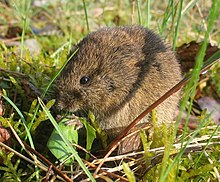
Rodents make up the largest order of mammals, with over 40% of mammalian species. They have two incisors in the upper and lower jaw which grow continually and must be kept short by gnawing.
- Suborder: Sciurognathi
- Family: Sciuridae (squirrels)
- Subfamily: Sciurinae
- Tribe: Sciurini
- Genus: Sciurus
- Red squirrel, S. vulgaris LC[1]
- Genus: Sciurus
- Tribe: Sciurini
- Subfamily: Sciurinae
- Family: Castoridae (beavers)
- Genus: Castor
- American beaver, C. canadensis LC introduced
- Eurasian beaver, C. fiber LC
- Genus: Castor
- Family: Gliridae (dormice)
- Subfamily: Leithiinae
- Genus: Eliomys
- Garden dormouse, E. quercinus NT[2]
- Genus: Eliomys
- Subfamily: Leithiinae
- Family: Cricetidae
- Subfamily: Cricetinae
- Genus: Cricetus
- European hamster, C. cricetus CR[3]
- Genus: Cricetus
- Subfamily: Arvicolinae
- Genus: Arvicola
- European water vole, A. amphibius LC[4]
- Genus: Clethrionomys
- Bank vole, Clethrionomys glareolus LC
- Genus: Microtus
- Field vole, Microtus agrestis LC
- Common vole, Microtus arvalis LC
- European pine vole, Microtus subterraneus LC
- Genus: Arvicola
- Subfamily: Cricetinae
- Family: Muridae (mice, rats, voles, gerbils, hamsters, etc.)
- Subfamily: Murinae
- Genus: Apodemus
- Yellow-necked mouse, Apodemus flavicollis LC
- Wood mouse, Apodemus sylvaticus LC
- Genus: Apodemus
- Subfamily: Murinae
- Family: Sciuridae (squirrels)
Order: Lagomorpha (lagomorphs)
[edit]The lagomorphs comprise two families, Leporidae (hares and rabbits), and Ochotonidae (pikas). Though they can resemble rodents, and were classified as a superfamily in that order until the early 20th century, they have since been considered a separate order. They differ from rodents in a number of physical characteristics, such as having four incisors in the upper jaw rather than two.
- Family: Leporidae (rabbits and hares)
- Genus: Lepus
- European hare, L. europaeus LC
- Genus: Oryctolagus
- European rabbit, O. cuniculus EN introduced
- Genus: Lepus
Order: Erinaceomorpha (hedgehogs and gymnures)
[edit]
The order Erinaceomorpha contains a single family, Erinaceidae, which comprise the hedgehogs and gymnures. The hedgehogs are easily recognised by their spines while gymnures look more like large rats.
- Family: Erinaceidae (hedgehogs)
- Subfamily: Erinaceinae
- Genus: Erinaceus
- West European hedgehog, E. europaeus LC[5]
- Genus: Erinaceus
- Subfamily: Erinaceinae
Order: Soricomorpha (shrews, moles, and solenodons)
[edit]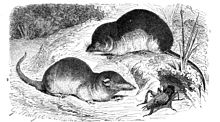

The "shrew-forms" are insectivorous mammals. The shrews and solenodons closely resemble mice while the moles are stout-bodied burrowers.
- Family: Soricidae (shrews)
- Subfamily: Crocidurinae
- Genus: Crocidura
- Bicolored shrew, C. leucodon LC
- Greater white-toothed shrew, C. russula LC
- Genus: Crocidura
- Subfamily: Soricinae
- Tribe: Nectogalini
- Genus: Neomys
- Eurasian water shrew, N. fodiens LC
- Genus: Neomys
- Tribe: Soricini
- Genus: Sorex
- Common shrew, S. araneus LC
- Eurasian pygmy shrew, S. minutus LC
- Genus: Sorex
- Tribe: Nectogalini
- Subfamily: Crocidurinae
- Family: Talpidae (moles)
- Subfamily: Talpinae
- Tribe: Talpini
- Genus: Talpa
- European mole, T. europaea LC
- Genus: Talpa
- Tribe: Talpini
- Subfamily: Talpinae
Order: Chiroptera (bats)
[edit]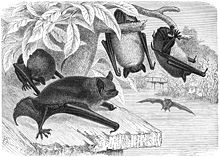
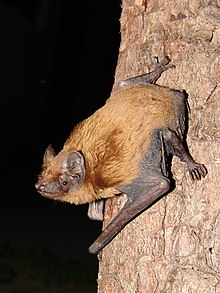


The bats' most distinguishing feature is that their forelimbs are developed as wings, making them the only mammals capable of flight. Bat species account for about 20% of all mammals.
- Family: Vespertilionidae
- Subfamily: Myotinae
- Genus: Myotis
- Brandt's bat, M. brandti LC
- Pond bat, M. dasycneme NT[6]
- Daubenton's bat, M. daubentonii LC
- Greater mouse-eared bat, M. myotis LC[7]
- Whiskered bat, M. mystacinus LC[8]
- Natterer's bat, M. nattereri LC[9]
- Genus: Myotis
- Subfamily: Vespertilioninae
- Genus: Barbastella
- Western barbastelle, B. barbastellus NT[10]
- Genus: Eptesicus
- Serotine bat, E. serotinus LC
- Genus: Nyctalus
- Common noctule, N. noctula LC[11]
- Lesser noctule, N. leisleri LC[12]
- Genus: Pipistrellus
- Nathusius' pipistrelle, P. nathusii LC[13]
- Common pipistrelle, P. pipistrellus LC
- Genus: Plecotus
- Brown long-eared bat, P. auritus LC[14]
- Grey long-eared bat, P. austriacus LC
- Genus: Barbastella
- Subfamily: Myotinae
- Family: Rhinolophidae
- Subfamily: Rhinolophinae
- Genus: Rhinolophus
- Greater horseshoe bat, R. ferrumequinum LC[15]
- Lesser horseshoe bat, R. hipposideros LC[16]
- Genus: Rhinolophus
- Subfamily: Rhinolophinae
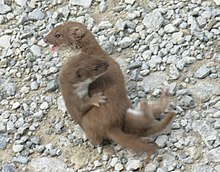

There are over 260 species of carnivorans, the majority of which feed primarily on meat. They have a characteristic skull shape and dentition.
- Suborder: Feliformia
- Family: Felidae (cats)
- Subfamily: Felinae
- Genus: Felis
- European wildcat, F. silvestris LC[17]
- Genus: Felis
- Subfamily: Felinae
- Family: Felidae (cats)
- Suborder: Caniformia
- Family: Canidae (dogs, foxes)
- Family: Mustelidae (mustelids)
- Genus: Lutra
- European otter, L. lutra NT[20]
- Genus: Martes
- European pine marten, M. martes LC[21]
- Beech marten, M. foina LC[22]
- Genus: Meles
- European badger, M. meles LC[23]
- Genus: Mustela
- Stoat, M. erminea LC[24]
- Least weasel, M. nivalis LC[25]
- European polecat, M. putorius LC[26]
- Genus: Neogale
- American mink, N. vison LC presence uncertain, introduced[27]
- Genus: Lutra
Order: Artiodactyla (even-toed ungulates)
[edit]The even-toed ungulates are ungulates whose weight is borne about equally by the third and fourth toes, rather than mostly or entirely by the third as in perissodactyls. There are about 220 artiodactyl species, including many that are of great economic importance to humans.
- Family: Cervidae (deer)
- Subfamily: Cervinae
- Genus: Cervus
- Red deer, C. elaphus LC[28]
- Central European red deer, C. e. hippelaphus
- Red deer, C. elaphus LC[28]
- Genus: Dama
- European fallow deer, D. dama LC introduced[29]
- Genus: Cervus
- Subfamily: Capreolinae
- Subfamily: Cervinae
- Family: Suidae (pigs)
- Subfamily: Suinae
- Genus: Sus
- Wild boar, S. scrofa LC[31]
- Central European boar, S. s. scrofa
- Wild boar, S. scrofa LC[31]
- Genus: Sus
- Subfamily: Suinae
Locally extinct
[edit]The following species are locally extinct in the country:
- Brown bear, Ursus arctos[32]
- European bison, Bison bonasus
See also
[edit]- List of chordate orders
- Lists of mammals by region
- List of prehistoric mammals
- Mammal classification
- List of mammals described in the 2000s
References
[edit]- ^ IUCN (2023-03-29). Sciurus vulgaris: Gazzard, A.: The IUCN Red List of Threatened Species 2023: e.T221730864A221731049 (Report). International Union for Conservation of Nature. doi:10.2305/iucn.uk.2023-1.rlts.t221730864a221731049.en.
- ^ Bertolino, S.; Amori, G.; Henttonen, H.; Zagorodnyuk, I.; Zima, J.; Juškaitis, R.; Meinig, H. & Kryštufek, B. (2008). "Eliomys quercinus". IUCN Red List of Threatened Species. 2008: e.T7618A12835766.
- ^ Banaszek, A.; Bogomolov, P.; Feoktistova, N.; La Haye, M.; Monecke, S.; Reiners, T. E.; Rusin, M.; Surov, A.; Weinhold, U. & Ziomek, J. (2020). "Cricetus cricetus". IUCN Red List of Threatened Species. 2020: e.T5529A111875852.
- ^ Batsaikhan, N.; Henttonen, H.; Meinig, H.; Shenbrot, G.; Bukhnikashvili, A.; Hutterer, R.; Kryštufek, B.; Yigit, N.; Mitsain, G. & Palomo, L. (2016). "Arvicola amphibius". IUCN Red List of Threatened Species. 2016: e.T2149A115060819.
- ^ Amori, G. (2016). "Erinaceus europaeus". IUCN Red List of Threatened Species. 2016: e.T29650A2791303.
- ^ Piraccini, R. (2016). "Myotis dasycneme". IUCN Red List of Threatened Species. 2016: e.T14127A22055164.
- ^ Coroiu, I.; Juste, J. & Paunović, M. (2016). "Myotis myotis". IUCN Red List of Threatened Species. 2016: e.T14133A22051759.
- ^ Coroiu, I. (2016). "Myotis mystacinus". IUCN Red List of Threatened Species. 2016: e.T14134A22052250.
- ^ Gazaryan, S.; Kruskop, S.V. & Godlevska, L. (2020). "Myotis nattereri". IUCN Red List of Threatened Species. 2020: e.T85733032A22052584.
- ^ Piraccini, R. (2016). "Barbastella barbastellus". IUCN Red List of Threatened Species. 2016: e.T2553A22029285.
- ^ Csorba, G. & Hutson, A.M. (2016). "Nyctalus noctula". IUCN Red List of Threatened Species. 2016: e.T14920A22015682.
- ^ Juste, J. & Paunović, M. (2016). "Nyctalus leisleri". IUCN Red List of Threatened Species. 2016: e.T14919A22016159.
- ^ Hutson, A. M.; Spitzenberger, F.; Juste, J.; Aulagnier, S.; Palmeirim, J.; Karatas, A. & Paunovic, M. (2010). "Pipistrellus nathusii". IUCN Red List of Threatened Species. 2010: e.T17316A6966886.
- ^ Gazaryan, S.; Kruskop, S.V. & Godlevska, L. (2021) [errata version of 2020 assessment]. "Plecotus auritus". IUCN Red List of Threatened Species. 2020: e.T85535522A195861341.
- ^ Piraccini, R. (2016). "Rhinolophus ferrumequinum". IUCN Red List of Threatened Species. 2016: e.T19517A21973253.
- ^ Taylor, P. (2016). "Rhinolophus hipposideros". IUCN Red List of Threatened Species. 2016: e.T19518A21972794.
- ^ Gerngross, P.; Ambarli, H.; Angelici, F.M.; Anile, S.; Campbell, R.; Ferreras de Andres, P.; Gil-Sanchez, J.M.; Götz, M.; Jerosch, S.; Mengüllüoglu, D.; Monterosso, P. & Zlatanova, D. (2022). "Felis silvestris". IUCN Red List of Threatened Species. 2022: e.T181049859A181050999. doi:10.2305/IUCN.UK.2022-1.RLTS.T181049859A181050999.en. Retrieved 3 August 2022.
- ^ Boitani, L.; Phillips, M. & Jhala, Y. (2018). "Canis lupus". IUCN Red List of Threatened Species. 2018: e.T3746A163508960.
- ^ Hoffmann, M.; Sillero-Zubiri, C. (2016). "Vulpes vulpes". IUCN Red List of Threatened Species. 2016: e.T23062A46190249.
- ^ Roos, A.; Loy, A.; de Silva, P.; Hajkova, P. & Zemanová, B. (2015). "Lutra lutra". IUCN Red List of Threatened Species. 2015: e.T12419A21935287.
- ^ Herrero, J.; Kranz, A.; Skumatov, D.; Abramov, A.V.; Maran, T. & Monakhov, V.G. (2016). "Martes martes". IUCN Red List of Threatened Species. 2016: e.T12848A45199169.
- ^ Abramov, A.V.; Kranz, A.; Herrero, J.; Krantz, A.; Choudhury, A. & Maran, T. (2016). "Martes foina". IUCN Red List of Threatened Species. 2016: e.T29672A45202514.
- ^ Kranz, A.; Abramov, A. V.; Herrero, J. & Maran, T. (2016). "Meles meles". IUCN Red List of Threatened Species. 2016: e.T29673A45203002.
- ^ Reid, F.; Helgen, K. & Kranz, A. (2016). "Mustela erminea". IUCN Red List of Threatened Species. 2016: e.T29674A45203335.
- ^ McDonald, R. A.; Abramov, A. V.; Stubbe, M.; Herrero, J.; Maran, T.; Tikhonov, A.; Cavallini, P.; Kranz, A.; Giannatos, G.; Kryštufek, B. & Reid, F. (2019). "Mustela nivalis". IUCN Red List of Threatened Species. 2019: e.T70207409A147993366.
- ^ Skumatov, D.; Abramov, A.V.; Herrero, J.; Kitchener, A.; Maran, T.; Kranz, A.; Sándor, A.; Stubbe, M.; Saveljev, A.; Savour-Soubelet, A.; Guinot-Ghestem, M.; Zuberogoitia, I.; Birks, J.D.S.; Weber, A.; Melisch, R. & Ruette, S. (2016). "Mustela putorius". IUCN Red List of Threatened Species. 2016: e.T41658A45214384.
- ^ Reid, F.; Schiaffini, M.; Schipper, J. (2016). "Neovison vison". IUCN Red List of Threatened Species. 2016: e.T41661A45214988.
- ^ Lovari, S.; Lorenzini, R.; Masseti, M.; Pereladova, O.; Carden, R.F.; Brook, S.M. & Mattioli, S. (2018). "Cervus elaphus". IUCN Red List of Threatened Species. 2018: e.T55997072A142404453.
- ^ Masseti, M.; Mertzanidou, D. (2008). "Dama dama". IUCN Red List of Threatened Species. 2008: e.T42188A10656554. doi:10.2305/IUCN.UK.2008.RLTS.T42188A10656554.en. Retrieved 19 November 2021.
- ^ Lovari, S.; Herrero, J.; Masseti, M.; Ambarli, H.; Lorenzini, R. & Giannatos, G. (2016). "Capreolus capreolus". IUCN Red List of Threatened Species. 2016: e.T42395A22161386.
- ^ Keuling, O. & Leus, K. (2019). "Sus scrofa". IUCN Red List of Threatened Species. 2019: e.T41775A44141833.
- ^ McLellan, B. N.; Proctor, M. F.; Huber, D. & Michel, S. (2017). "Ursus arctos". IUCN Red List of Threatened Species. 2017: e.T41688A121229971.
External links
[edit]- "Animal Diversity Web". University of Michigan Museum of Zoology. 1995–2006. Retrieved 22 May 2007.


 French
French Deutsch
Deutsch